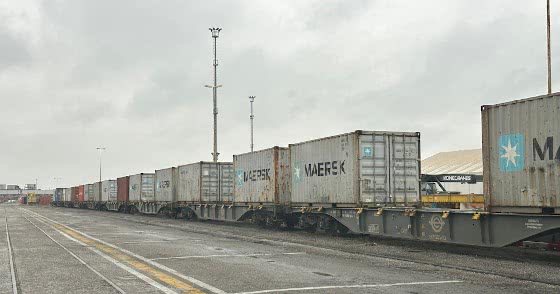
After an initial test phase that took place in recent weeks, it has been
a new rail link between the
platforms of the Vecon-PSA Venice terminal in Marghera and the terminal
intermodal hub of Montirone in the province of Brescia, one of the
main areas on which the MIS - Magli Intermodal Service group operates,
specialized in the logistics of steel products. The train
provides for a conformation of 23 60-foot wagons with a capacity
of loading 46 containers and the initial programming provides for 50
rotations per year with the aim of increasing the frequency of
intercepting other containerized cargo. Paolo Magli
President of the MIS Group, thanking you for your trust
by GME Metals, which uses the new service for the import of
of ferroalloys, said he was certain that "together with the partner
Vecon-PSA Venice we could further develop the frequency of the
intercepting additional volumes of containerized goods
extending the range of action of the port of Venice".
The expected further development is also based on the
possibility of further forwarding of loads to markets
thanks to the active connection between Montirone and Rotterdam,
always operated by the MIS group with the traction of SBB, the customers of the
new service will be able to extend the reference market
to Benelux and the United Kingdom, saving time and emissions of
CO2 compared to the transit time of services to and from the East
they pass through Suez and continue beyond Gibraltar to Northern Europe,
UK, Ireland and Scandinavia.
Specifying that GME Metals has been reviewing the processes for some time
focusing on rail transport, "now - explained
Andrea Quaresmini, CEO of the company - we have
decided to take a further step forward, withdrawing by train from the
port of Marghera material to be stored in our warehouses. Thus
a new warehouse was chosen in Montirone opposite the
dry port that manages MIS. After the first tests we are sure that the
this is the way to be pursued. Europe asks us to reduce
CO2 emissions, customers (steel mills and cast iron foundries
located throughout Europe) therefore must act accordingly; we
We do our part by choosing suppliers who
meet this need more and on the other hand
using rail transport as much as possible to have
Thus ferroalloys with lower carbon footprint
possible".
Expressing satisfaction with the partnership with MIS, Daniele
Marchiori, general manager of PSA Venice-Vecon, highlighted that
"one of the business objectives of Vecon-PSA Venice is
to ensure a sustainable supply chain: why
transport 40 containers by truck from the port of Venice to Brescia
When can you make a block train? It means reducing CO2,
greater safety on the roads and certainty of transit times".
Commenting on the launch of the new connection, the president
of the Port System Authority of the Adriatic Sea
Fulvio Lino Di Blasio, recalled that "in the
years the railway mode in the port of Venice is
constantly grew and, while in 2023 we recorded a
handling of over two million tons, from January to
September 2024 we have already exceeded 1.6 million tons
with an increase, compared to the same period of the year
by 6%". Di Blasio also recalled the
investments in progress by the port authority in the
"Just think - he specified - of the interventions
already started up such as the new railway bridge over the west canal,
24 million euro project that will allow the elimination of
interference and bottlenecks also in favor of terminals
commercial or traffic rationalisation works in the
of Electricity, worth 19 million euros, and to the
Interventions expected soon, such as the resolution of the Via node
of Chemistry for 15 million euros and the intermodal platform
the design of which provides for an amount of 1.2 million euros.
We are convinced - he underlined - that, also through these
interventions, the Authority can contribute to increasing the
environmental sustainability of the port of Venice, bringing the
Veneto system to transport standards at European level as well as
ensuring greater logistical efficiency at the airport by allowing
sectors, such as containerized goods, to reach
new markets and stimulate a decisive modal shift from road to
iron".
